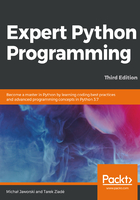
Understanding Python's Method Resolution Order
Python MRO is based on C3, the MRO built for the Dylan programming language (http://opendylan.org). The reference document, written by Michele Simionato, can be found at http://www.python.org/download/releases/2.3/mro. It describes how C3 builds the linearization of a class, also called precedence, which is an ordered list of the ancestors. This list is used to seek an attribute. The C3 algorithm is described in more detail later in this section.
The MRO change was made to resolve an issue introduced with the creation of a common base type (that is, object type). Before the change to the C3 linearization method, if a class had two ancestors (refer to Figure 1), the order in which methods were resolved was quite simple to compute and track only for simple cases that didn't use multiple inheritance model in a cascading way.
Here is an example of code, which, under Python 2, would not use C3 as an MRO:
class Base1:
pass
class Base2:
def method(self):
print('Base2')
class MyClass(Base1, Base2):
pass
>>> MyClass().method()
Base2
When MyClass().method() is called, the interpreter looks for the method in MyClass, then Base1, and then eventually finds it in Base2:

When we introduce some CommonBase class at the top of our class hierarchy (both Base1 and Base2 will inherit from it, refer to Figure 2), things will get more complicated. As a result, the simple resolution order that behaves according to the left-to-right depth first rule is getting back to the top through the Base1 class before looking into the Base2 class. This algorithm results in a counterintuitive output. In some cases, the method that is executed may not be the one that is the closest in the inheritance tree.
Such an algorithm is still available in Python 2 for old-style classes. Here is an example of the old method resolution in Python 2 using old-style classes:
class CommonBase:
def method(self):
print('CommonBase')
class Base1(CommonBase):
pass
class Base2(CommonBase):
def method(self):
print('Base2')
class MyClass(Base1, Base2):
pass
The following transcript from the interactive session shows that Base2.method() will not be called despite the Base2 class being closer in the class hierarchy to MyClass than CommonBase:
>>> MyClass().method() CommonBase

Such an inheritance scenario is extremely uncommon, so this is more a problem of theory than practice. The standard library does not structure the inheritance hierarchies in this way, and many developers think that it is bad practice. But, with the introduction of object at the top of the types hierarchy, the multiple inheritance problem pops up on the C side of the language, resulting in conflicts when doing subtyping. You should also note that every class in Python 3 has now got the same common ancestor. Since making it work properly with the existing MRO involved too much work, a new MRO was a simpler and quicker solution.
So, the same example run under Python 3 gives a different result:
class CommonBase:
def method(self):
print('CommonBase')
class Base1(CommonBase):
pass
class Base2(CommonBase):
def method(self):
print('Base2')
class MyClass(Base1, Base2):
pass
And here is the usage example showing that C3 serialization will pick the method of the closest ancestor:
>>> MyClass().method() Base2
The Python MRO is based on a recursive call over the base classes. To summarize the Michele Simionato paper referenced at the beginning of this section, the C3 symbolic notation applied to our example is as follows:
L[MyClass(Base1, Base2)] =
MyClass + merge(L[Base1], L[Base2], Base1, Base2)
Here, L[MyClass] is the linearization of MyClass, and merge is a specific algorithm that merges several linearization results.
So, a synthetic description would be, as Simionato says:
The merge algorithm is responsible for removing the duplicates and preserving the correct ordering. It is described in the paper like this (adapted to our example):
The head is the first element of a list and the tail contains the rest of the elements. For example, in (Base1, Base2, ..., BaseN), Base1 is the head, and (Base2, ..., BaseN) is the tail.
In other words, C3 does a recursive depth lookup on each parent to get a sequence of lists. Then, it computes a left-to-right rule to merge all lists with a hierarchy disambiguation, when a class is involved in several lists.
So the result is as follows:
def L(klass):
return [k.__name__ for k in klass.__mro__]
>>> L(MyClass)
['MyClass', 'Base1', 'Base2', 'CommonBase', 'object']
You can also call MyClass.mro() to compute and get the result. This is another reason why classes in Python 2 should be taken with an extra case. While old-style classes in Python 2 have some defined order in which methods are resolved, they do not provide the __mro__ attribute and the mro() method. So, despite the order of resolution, it is wrong to say that they have MRO. In most cases, whenever someone refers to MRO in Python, it means that they are referring to the C3 algorithm described in this section.
Let's now discuss some of the shortcomings faced by programmers.